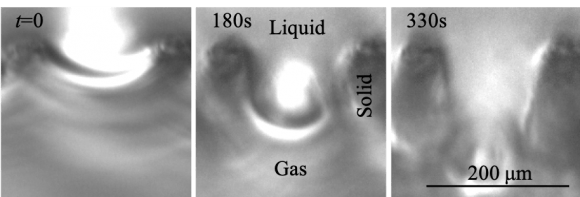Multiphase Flows
Dynamic of Gas Bubbles on Solid-Liquid Interface
Some hydrophobic materials in nature, e.g., lotus leaf, have micro/nano-scale surface roughness and are extremely difficult to be wetted. These materials are called super-hydrophobic surfaces (SHSs). When immersing in water, the SHSs can entrap micron size air bubbles between the roughness elements, separating the solid wall with the liquid. Artificial SHSs have been fabricated and found applications in numerous areas including antifogging, anti-icing, anticorrosion, and drag reduction. All these applications rely on the existence of gas bubbles at the solid-liquid interface. Once the gas bubbles are replaced by liquid, the surface is wetted, known as wetting transition. In our lab, we are using microscopic imaging to study the dynamic of gas bubble on SHS subjected to gas diffusion, high pressure, turbulent flows, etc. In collaborating with material scientists, we aim to develop long-life super-hydrophobic surfaces.

Deformation and breakup of droplets in the liquid-liquid system
It is very common that a liquid droplet deforms in another immersible ambient liquid, e.g., the oil leakage in bottom ocean, the atomization of fuels, and the transportation of oil/water mixture. The liquid droplet can breakup into smaller ones if the deformation is large enough. We use high-speed imaging to understand the behavior of droplet in a liquid-liquid two phase system.

- Ling H, Fu M, Hultmark M, Katz J (2017) Effect of Reynolds number and saturation level on gas diffusion in and out of a super-hydrophobic surface. Phys. Rev. Fluids. 2, 124005.
